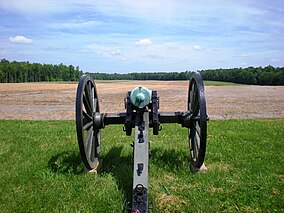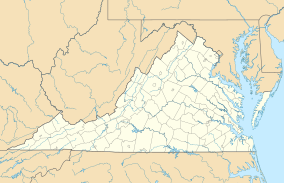Richmond National Battlefield Park
| Richmond National Battlefield Park | |
|---|---|
|
IUCN category V (protected landscape/seascape)
|
|

Union gun position at Malvern Hill
|
|
| Location | Richmond, Hanover County, Henrico County, Chesterfield County, Virginia, USA |
| Nearest city | Richmond, Virginia |
| Coordinates | 37°25′45″N 77°22′25″W / 37.42917°N 77.37361°WCoordinates: 37°25′45″N 77°22′25″W / 37.42917°N 77.37361°W |
| Area | 3,629.2 acres (14.687 km2) |
| Established | March 2, 1936 |
| Visitors | 94,967 (in 2016) |
| Governing body | National Park Service |
| Website | Richmond National Battlefield Park |
|
Richmond National Battlefield Park
|
|
| NRHP Reference # | |
| VLR # | 043-0033 |
| Significant dates | |
| Added to NRHP | October 15, 1966 |
| Designated VLR | January 16, 1973 |
Richmond National Battlefield Park commemorates 13 American Civil War sites around Richmond, Virginia, which served as the capital of the Confederate States of America for the majority of the war. The park is focused around the home front within the city, defensive fortifications surrounding the city, as well as a number military actions taken in an attempt to capture or defend the city, including the Seven Days Battles of 1862, battles of the Overland Campaign of 1864, and the Richmond-Petersburg Campaign of 1864-65. Its various sites are spread across Richmond, Hanover County, Henrico County, and Chesterfield County.
As the industrial and political capital of the Confederacy, Richmond was the ultimate goal for the Union army and a major center of armed conflict throughout the Civil War, particularly during the Seven Days Battles and the Overland Campaign. After the Confederate attack on Fort Sumter in 1861, Virginia seceded to join the Confederacy; while individual people had a variety of personal reasons for supporting the Union or the Confederacy, the conflict was centered upon contention over the existence and expansion of slavery.
The Seven Days Battles were a series of six major battles which occurred between June 25 and July 1, 1862 near Richmond. The two competing armies were the Army of the Potomac, led by Union General George B. McClellan, and the Army of Northern Virginia, led by Confederate General Robert E. Lee. The battles were the last conflicts of the Peninsula Campaign, in which Union forces attempted to capture the Confederate capital to quickly end the war. The Seven Days Battles included battles at Oak Grove, Beaver Dam Creek (Lee's first battle as commander of the Army of Northern Virginia ), Gaines’ Mill, Garnett's and Golding's Farm, Savage's Station, Glendale, and Malvern Hill (Richmond National Battlefield Park's preserved lands includes Beaver Dam Creek, Gaines’ Mill, Glendale, and Malvern Hill ). Union leaders commonly thought the Confederacy would not be able to contend with the Union military and expected the conflict to be fairly brief and straightforward. During the Seven Days Battles, McClellan quickly realized that he would not be successful in capturing Richmond so soon and began to retreat back to safety. Lee attempted to intercept them at Glendale, but, due to poorly executed orders, Confederate forces could not organize in time and McClellan was able to take a strong defensive position at Malvern Hill. Malvern Hill was an extremely lopsided affair in which Confederate forces futilely attempted to charge directly at strong infantry and artillery defenses. After the battle, Confederate Major General D.H. Hill said "It was not war; it was murder." With Richmond no longer a viable Union target, conflict moved north for the Northern Virginia Campaign and the Maryland Campaign.
...
Wikipedia




